Bulgarian–Hungarian wars
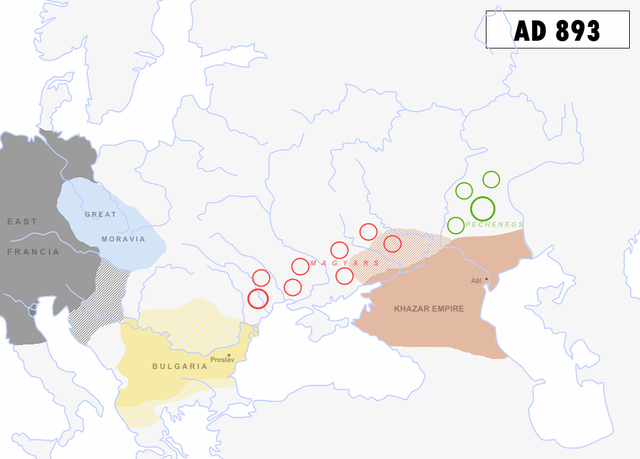
Bulgarian–Hungarian wars

| Bulgarian–Hungarian Wars | |||||||||
|---|---|---|---|---|---|---|---|---|---|
| |||||||||
| Belligerents | |||||||||
| Commanders and leaders | |||||||||
| Boris I Simeon I Duke Glad Duke Menumorut Samuil Duke Ahtum Constantine Tikh Asen Duke Gelou | Árpád Stephen I Andrew II Béla IV Stephen Magister Laurentius Louis I | ||||||||
The Bulgarian–Hungarian wars were a series of conflicts that occurred during the 9th–14th centuries between the Bulgarian Empire and the Kingdom of Hungary. The nearly 500-year conflict encompassed the northern and western Balkans, or what is known today as north-western Serbia, Romania and northern Bulgaria.
The first clashes occurred in the late 9th century, in which the Hungarians were pushed west. Later, during the 10th century, the Hungarians overran the Bulgarian dukes in what is now Transylvania and conquered the eastern parts of the Pannonian Plain. Their raids against Bulgaria continued until the middle of the century when peace was restored. Both countries sustained friendly relations until 1003 when another war broke out, further diminishing Bulgarian power in Eastern Europe.
In 1185, after the re-establishment of the Bulgarian Empire, both states fought numerous conflicts for control over the provinces of Belgrade, Branicevo, Vidin and Severin Banat.
| Bulgarian–Hungarian Wars | |||||||||
|---|---|---|---|---|---|---|---|---|---|
| |||||||||
| Belligerents | |||||||||
| Commanders and leaders | |||||||||
| Boris I Simeon I Duke Glad Duke Menumorut Samuil Duke Ahtum Constantine Tikh Asen Duke Gelou | Árpád Stephen I Andrew II Béla IV Stephen Magister Laurentius Louis I | ||||||||
Hungarian conquest (War of 894–896)
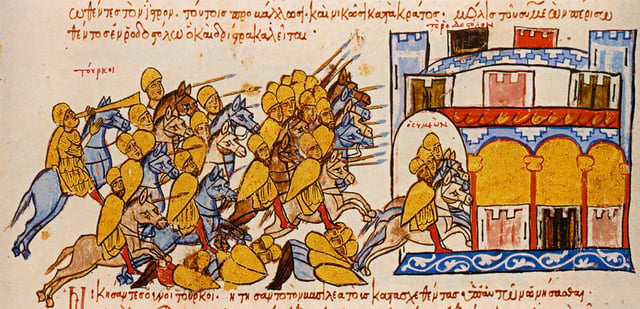
The Bulgarians flee to Silistra after the defeat by the Hungarians.
In 862, at the invitation of their ally the Moravian leader Rastislav, the Hungarians first raided Pannonia. The following year, Louis the German, king of Eastern Francia, retaliated by forging an alliance with the Bulgarians. Boris I of Bulgaria sent mounted troops to help defeat Rastislav. This retaliation began an ongoing conflict which lasted for 25 years, pitting Hungarians and Moravians against Bulgarians and Franks.
The Hungarian Conquest was one of the factors that upset this military balance. In 881, prior to the Conquest, the Moravian Svatopluk received assistance from the Hungarians who advanced as far as Vienna. Two years later, Svatopluk suffered a punishing blow from the Bulgarians. In 892, when Svatopluk once again refused to pay obeisance to the Franks, his Hungarian allies continued to aid him, but the Bulgarians retaliated again.
The situation took a decisive turn in September 892, when the Bulgarian Prince Vladimir informed the Frankish king Arnulf's envoys that the Franks could no longer count on his military aid in the Carpathian Basin; the Bulgarians were only prepared to halt salt deliveries to the enemy. The Frank delegation was still there when Simeon I of Bulgaria ascended to the Bulgarian throne.
In response, the Byzantine Emperor Leo VI's envoy Niketas Skleros met on the Lower Danube with the Hungarian ruling princes Árpád and Kurszán, and they agreed to form an alliance. As a result, a Hungarian force (an army of the Hungarians' Kabar auxiliaries, and possibly the Székelys), led by Árpád's son, Liüntika (Levente), was ferried across the Danube by the Byzantines and attacked Simeon's Bulgarians from the rear. Simeon suspended his campaign against Byzantium to turn against the Hungarians. Defeated by the Hungarians, he sought refuge in the castle at Drastar (Silistra).
That same year, in 894, Hungarian warriors advanced into the Carpathian Basin and Pannonia to aid the Moravians in their fight against the Bulgarians' Frankish allies. When they learned of Svatopluk's death, the Hungarians pulled back, though only as far as the region of the Upper Tisza. In spring 895, Árpád followed with his army and, after some skirmishes on the Great Plain, defeated the Bulgarian army. Having hurriedly made peace with Byzantium, the Bulgarians concentrated their forces to defeat Liüntika's Hungarians.
After the Hungarians retreated, Simeon pretended to agree to negotiations – but the Byzantine envoy Leo Chirosphact who arrived to the Bulgarian capital Preslav was put in custody and Simeon deliberately prolonged the peace talks. In the meantime he allied with the Pechenegs and simultaneously launched attacks on the Hungarian encampments in the Etelköz. In the bloody battle of Southern Buh the Bulgarians led by Simeon I and his father Boris I decisively defeated the Hungarians. The ensuing, massive withdrawal by the Hungarians ended in the 'conquest', or rather settlement, of what became the Hungarian's permanent homeland. Soon after the Bulgarian victory, the Simeon stopped the negotiations and in the summer of 896 the Byzantine army was routed at Boulgarophygon.
When the Hungarians arrived to settle in the Carpathian Basin, they encountered little resistance on the part of the Bulgarians. The small but noteworthy communities implanted by the Bulgarians in Transylvania and between the Tisa and Danube did not even have the option of fleeing from the Hungarians, who came in overwhelming force. Likewise the Moravians came under Hungarian rule but continued to use their burial grounds (e.g. Maroskarna) into the early 10th century.
Conflicts in 10th century
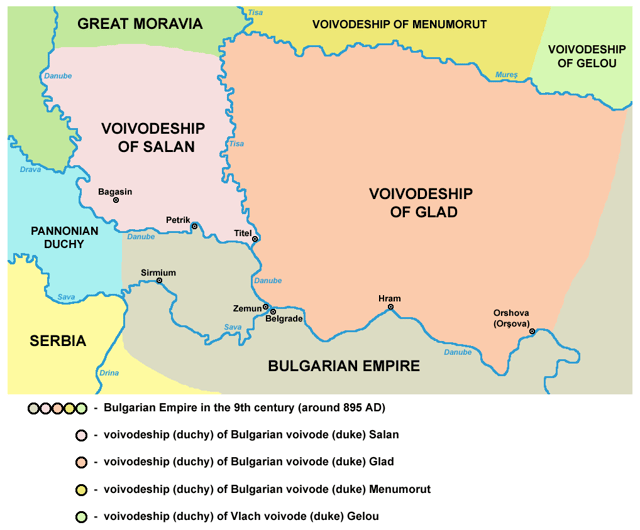
The duchies of Glad and Salan within the Bulgarian Empire. The lands of Menumorut were located to the north of Glad's duchy.
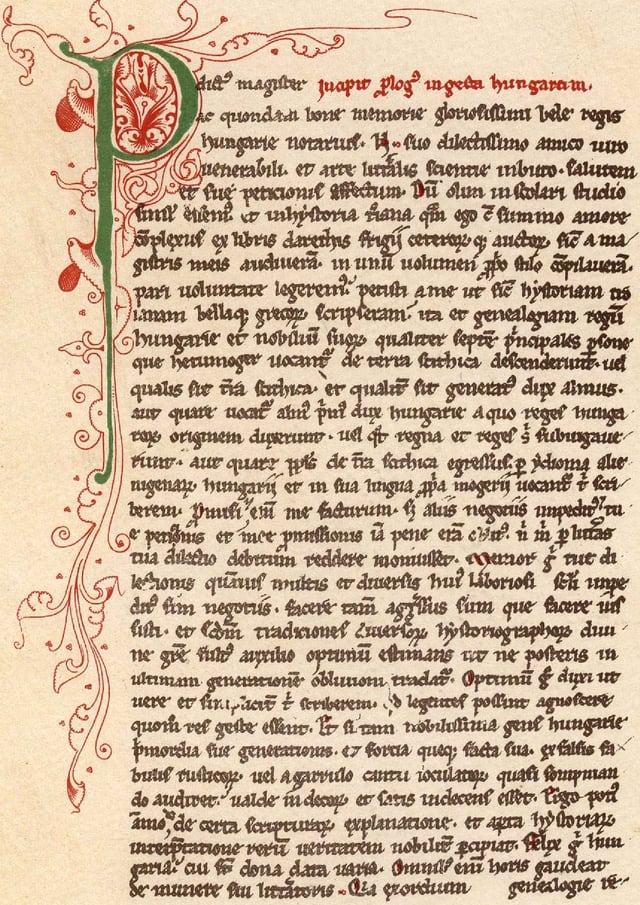
The first page of Gesta Hungarorum – a medieval Hungarian manuscript which is one of the main sources for the Hungarian conquest. However, it mixes ascertainably correct facts, inaccuracies and information that cannot be confirmed from other sources. Some parts are considered by most modern authors as simply inventions (by the author or by his predecessors) to contradict Frankish and other chronicles.
With the emergence of the Árpád dynasty after Kurszán's death, a new clan ruled over the Hungarians. There is no indication of the time when the ruling gyulas transferred their headquarters and residence to the middle Maros valley. The gyula must have been in charge of eastern and southern affairs, for he directed the raids against Byzantium and Bulgaria in April 934 and April 943.
The blows suffered at the hands of the Pechenegs and Bulgarians in 895–896 induced great caution in the Hungarians. Constantine Porphyrogenetos repeatedly noted that the Hungarians feared the Pechenegs, who were used by the Bulgarians to keep the Hungarians in check. When, early in the 10th century, Byzantine envoys urged the Hungarian leaders to attack the Pechenegs, their proposal was rejected on the grounds that it carried too many risks; in any case, the Hungarians had no intention of reoccupying the Etelköz, now held by the Pechenegs as far as the Danube delta. They tried to preserve peaceful relations with the Pechenegs so that they would be free to concentrate on more westerly targets. The Pechenegs, for their part, preferred to raid the richer lands of the Bulgarians and Byzantines rather than the poorer Carpathian Basin, which was in a state of some turmoil due to the Hungarian conquest. Thus the anti-Hungarian alliance of the Bulgarians and the Byzantine empire gradually fell apart, and the two old enemies, the Hungarians and the Pechenegs, pursued a rapprochement in the face of growing Bulgarian might.
In 913, Simeon launched the first in a series of military campaigns by which he seized from the Byzantines most of the Balkan Peninsula; six years later, he exchanged his title of Great Khan for that of Czar. He was not a man to let the salt mines and gold deposits of southern Transylvania pass into Hungarian hands without a fight. In order to conquer the rest of Transylvania as well as the region between the Maros, Tisza, and Danube rivers ('Glad's domain according to Anonymus, but most likely under Bulgarian rule), the Hungarians would need to ally themselves with the Pechenegs against the Bulgarians. The painful consequences of the alliance of Bulgarians and Pechenegs in 895 were still fresh in the Hungarians' memory. As long as the Pechenegs remained hostile, the Hungarians would not dare to provoke Simeon by seizing his lands north of the Carpathians and the Danube.
The opportunity came with the formation (ca. 932) of a Pecheneg–Hungarian alliance. It is possible that the gyula Bogát had acted earlier, but if not, he must have seized this chance to occupy southern Transylvania. In breaking the Bulgars' resistance, the Hungarians were helped not only by their Pecheneg allies but also by the internal struggle — exacerbated by Byzantine meddling — over the succession to Czar Simeon, who died in 927. This may have presented Bogát's successor, the gyula Zombor, with the opportunity to occupy the land lying between the Maros, Tisza, and Danube rivers.
Having seized southern Transylvania from the Bulgarians, Bogát's warriors and their servants settled down in Slavic villages along the lower reaches of the Küküllő rivers.
The region between the Mureș, Tisa, and Danube rivers must have come under the rule of a Hungarian gyula by 948, for that was when Emperor Constantine recorded that the Bulgarian cities Orșova, Belgrade, and Sirmium lay near Hungary's borders.
It was a sign of the gyulas' enhanced power that they launched the first Hungarian campaigns against Byzantium, cutting through the weakening defenses of the Bulgarians. According to Byzantine chronicles, the first campaign occurred in 934;[1] it ended in a peace treaty between Emperor Peter I of Bulgaria and the Hungarians. Another campaign, in 943, was terminated in similar fashion, and the Byzantines probably had to pay tribute.
In 948, a sudden turn of events compelled Transylvania's gyula to adopt a policy divergent from that of the ruling prince who had dispatched his nephew, and the harka Bulcsú to Constantinople, to renew the peace treaty; the envoys attached so much importance to the task that they had themselves baptized. It is likely that this gesture was motivated by Bulcsú's decision to launch new western raids; therefore he wanted to protect his rear from Byzantine attack. Some time after 952, the gyula Zombor also presented himself at Constantinople, but he came in his own right, and not as an envoy of the ruling prince. He, too, had himself baptized,[2] but his political goal was different from that of Bulcsú. Zombor was interested not in western raids but in the anti-Bulgarian plans of the Byzantine court. The latter had never given up its ambition to crush the Bulgarians and restore the old imperial borders on the Sava and Lower Danube rivers. The gyulas also considered the Bulgarians, from whom they had seized the territories that lay north of the Danube and the Carpathians, to be their principal enemy. The Árpádian ruling princes would have been satisfied with Byzantine neutrality, but the gyulas sought an alliance against the Bulgarians.
War of 1003
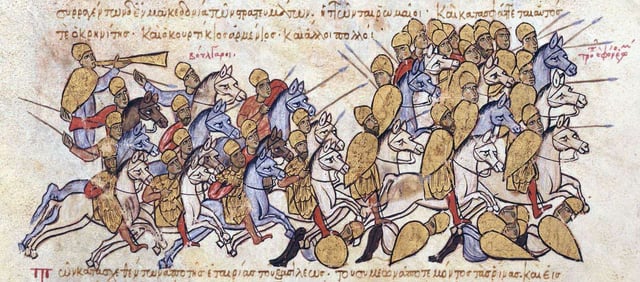
Tsar Symeon I of Bulgaria defeating the Byzantine army, led by Procopius Crenites and Curtacius the Armenian in Macedonia
Since the fall of the Bulgarian capital Preslav in 971 the Bulgarian and the Byzantine Empires were in a state of constant war. The Byzantine–Bulgarian conflict reached its height in 1003 with the involvement of Hungary. At that time the governor of the northwestern parts of Bulgaria was Duke Ahtum, the grandson of Duke Glad, who was defeated by the Hungarians in 930s. Ahtum commanded a strong army and firmly defended the northwestern borders of the Empire. He also built many churches and monasteries through which he spread Christianity in Transylvania.[3][4]
Although marriage of the heir to the Bulgarian throne Gavril Radomir to the daughter of the Hungarian ruler had established friendly relation between the two strongest states in the Danube area, the relationship deteriorated after Géza's death. The Bulgarians supported Gyula and Koppány as rulers instead of Géza's son Stephen I. As a result of the conflict, the marriage between Gavril Radomir and the Hungarian princess was dissolved. The Hungarians then attacked Ahtum, who had directly backed the pretenders for the Hungarian crown. Stephen I convinced Hanadin, Ahtum's right-hand man, to help in the attack. When the conspiracy was uncovered Hanadin fled and joined the Hungarian forces.[5] At the same time, a strong Byzantine army besieged Vidin, Ahtum's seat. Although many soldiers were required to participate in the defense of the town, Ahtum was occupied with the war to the north. After several months he died in battle when his troops were defeated by the Hungarians.[6] As a result of the war, Bulgarian influence to the northwest of the Danube diminished.
Conflicts in 14th century
Hungarian occupation of Vidin
See also
Bulgaria-Hungary relations
History of Hungary